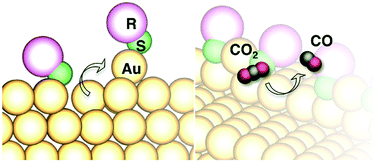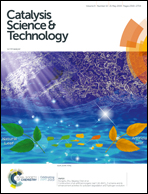CO2 electrochemical reduction at thiolate-modified bulk Au electrodes†
Abstract
Electrochemical reduction provides an opportunity to convert atmospheric CO2 to fuels or chemicals using renewable energy. In this work, we demonstrate unexpected influence on the catalytic activity and selectivity of the electrochemical CO2 reduction reaction (CO2RR) through the functionalization of Au with thiols. 2-Phenylethanethiol modified Au electrodes (2-PET-Au) show up to a 2-fold enhancement in both Faradaic efficiency and current density for CO evolution, between −0.6 and −0.9 V vs. the reversible hydrogen electrode. Functionalization with 2-mercaptopropionic acid, which has a readily ionized carboxylate group, leads to hydrogen evolution with up to 100% Faradaic efficiency at the expense of CO evolution. Remarkably, the adsorption of certain thiols on Au does not have a negative impact on the total current density compared to blank Au. We present evidence that it is due to ligand-induced reconstruction of Au surfaces resulting in the creation of structurally and chemically modified local reaction environments. Thus a thiol species such as 2-PET, which does not contain any nitrogen-based heterocycle with a charge transfer center, can induce the formation of active sites on Au that are electrochemically active toward CO2RR within the range of electrode potential that most of the ligand concentration remains stable on Au. Our findings suggest a simple, effective, and tunable way to modify the activity and selectivity of Au electrodes.

- This article is part of the themed collection: 2019 Catalysis Science & Technology HOT Articles


 Please wait while we load your content...
Please wait while we load your content...
